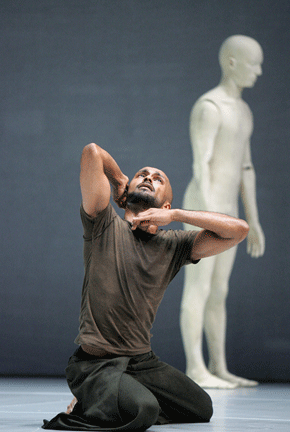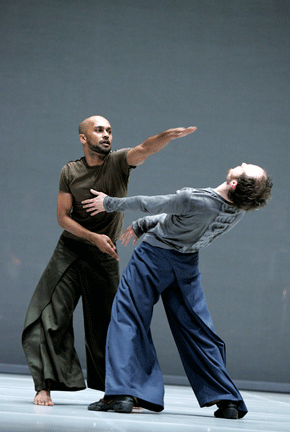About a decade ago, the London-born choreographer Akram Khan and his
Bangladeshi cousin were boarding a train from India to Bangladesh when
police confiscated their passports and wouldn’t return them until
Khan’s cousin slipped them some money. Then the cousins found a dead
man in their carriage.
Khan moved to help the man’s distraught wife, but his cousin told
him to stay put. “They’ll just blame you for the death,” he said. “They
need to blame someone, so they’ll blame you.” They’d recognize that
Khan was a foreigner–he had insubordination in his eyes–and they’d
throw him in prison and he’d never get out.
When Khan and the Moroccan-Belgian choreographer Sidi Larbi Cherkaoui sat down to plan a joint work in 2005, Cherkaoui asked Khan to tell him something he’d never told anyone before. Khan told this story. Now he and Cherkaoui tell it again at City Center this week.
Zero degrees–their harrowing dancing-talking duet–manages to be several things at once:
a confession; a meditation on confession (does it do any good?); and a powerful artifact of the crumbling end of these mendacious Bush years, when people are ravenous for public truth-telling and thoroughly disinclined to believe it.
Khan wants us to know about the police graft and the callous handling of the passenger’s death, but he’s also pointing the finger at himself for not stopping the bribe or helping with the passenger. To avoid a mise en abime of self-incrimination–guilt about even imagining it matters that one feels guilty–zero degrees does what most of us have been doing lately. It deploys the ironic confessional mode.
The train incident is recounted with all the idiosyncrasies of spontaneous speech–the stuttery sentences and the glorious ideograms that a dancer such as Khan, trained in the ancient, Indian storytelling form of kathak, paints in the air when he talks. But the men present the story together, in unison, like school boys. This confession is conspicuously staged.
What keeps zero degrees’ irony from shading into the usual contemporary flippancy, though, is the way the dancing fleshes out the talking.
“The body doesn’t lie,” Martha Graham once said–and dancers have repeated it ever since. But everything lies. The only difference is that the body is a model confessor: it believes what it says as soon as it says it. Cherkaoui and Khan show us the virtue and vice in that faith.
The dancing begins with the men delicately interlacing their limbs. Gradually their movement becomes more rhythmic and violent, until Khan is bending Cherkaoui around like a Gumby doll and bouncing him like a ball. When it gets to be too much, they transfer their passions, their misery and anger, to their doubles–pale rubber sculptures that the acclaimed British sculptor Antony Gormley cast from their bodies. The dummies have been lying on the stage from the start.
It feels terribly sad, the men pummeling their weightless doubles, sitting on them, dragging them around. It’s like a child hugging a doll when she has nothing else. The doll can only contain her feelings, it can’t offer any of its own. These sculptures are to the dancers as zero degrees is to the incident on the train. The dance can testify to senseless death and political corruption, but it can’t make them go away. It can’t change the world.
Even more than the disturbing story itself, the helpless melancholy that arises from it is what makes zero degrees so timely and also so much wiser than its time.
Zero degrees runs this Friday and Sunday at City Center in New York.
Here’s a very
short clip from the show. And here’s another.
Photos above: 1. Akram Khan and Antony Gormley sculpture. 2. Khan and Sidi Larbi Cherkaoui. Courtesy of New York City Center.



Thanks for this excellent review! I’m going to see his other work this weekend, and now I’m kind of sorry I didn’t choose to see this one. But I feel I “saw” it through you anyway — so thank you!
Apollinaire responds: oh, thank you, Tonya. This “zero degrees” really is something–and on a whole other level from “bahok,” the other offering. Plus, it’s a twofer–two hot European pomo wunderkind choreographers for one. I didn’t talk about how deep and true a collaboration it is, but you can see both influences: Cherkaoui’s structural/conceptual savvy and Khan’s gestural and musical power. Oh, wait–you SAW Cherkaoui’s stuff, with me: The final piece on that Geneva Ballet show at the Joyce, where they all ended up in a pile with one man on top, remember? Anyway, if you can possibly switch tickets, do. (And if you can’t, I’ll loan you my dvd.)